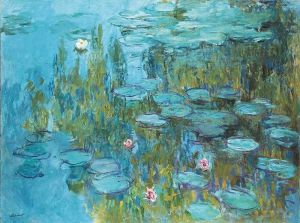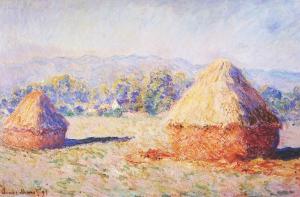Claude Monet and Impact of Japanese Art: Impressionism and Ukiyo-e
Lee Jay Walker
Modern Tokyo Times
Claude Monet was a very important artist within French Impressionism and despite new artistic movements like Cubism and Fauvism altering the artistic landscape, he remained firmly committed to this art movement. Another major art theme that would shape Claude Monet was Japanese ukiyo-e because he became immediately smitten by the contrasting approach to art. Therefore, Claude Monet utilized these two powerful art movements with the upshot being stunning fresh art pieces that remain etched within the memory.
The Impressionist art movement altered the artistic world dramatically because it created a new energy that incorporated enormous innovation. Indeed, for Claude Monet, and others, Impressionism was a philosophy that remained potent and buried within his artistic soul until parting from this world.
Claude Monet was born in 1840 in Paris and died in 1926. Throughout his long life, he created extremely stunning art pieces that remain internationally admired in modern times. From an early age Claude Monet adored art and in his formative years, he took lessons from Jacques-Francois Ochard. However, his early mentor who taught him about using oil paints was Eugene Boudin, a fellow artist, whom he met when still a teenager. Claude Monet and Eugene Boudin also benefitted from the influence of Johan Barthold Jongkind.
The year 1857 was very dramatic and full of sadness because Claude Monet’s mother died. From this period to the early 1860s he witnessed many highs and lows because other family members were opposed to his strong focus on art. In the early 1860s, he served in the French army in Algeria and was meant to have stayed for seven years. However, after suffering from typhoid fever he was allowed to leave after two years because of the actions of his aunt and the reported prompting of Johan Barthold Jongkind.
Claude Monet in 1862 could finally concentrate on art but he wasn’t interested in following traditional art because his eyes had been opened to new artistic concepts. He now became a student under Charles Gleyre in the dynamic city of Paris. In time he would meet powerful artists like Alfred Sisley, Pierre-Auguste Renoir, and Frederic Bazille. These artists were focused on new approaches to art and soon the Impressionist movement would radically alter the artistic landscape. Therefore, because of these individuals – and others who were dedicated to new artistic concepts – a rich flow of art would galvanize the art world that remains vibrant today despite the longevity of time.
The 1870s was a very dramatic period for Claude Monet because the Franco-Prussian war of 1870-1871 triggered many new events. This revolutionary fervor gripped Paris and led to many upheavals – while creating new ideas. During the same period, Claude Monet was touched by Japanese printmaking called ukiyo-e. This love affair would stay with him for the rest of his life. However, the death of his wife from tuberculosis in 1879 after several years of illness shattered Claude Monet because he doted on Camille Doncieux.
Turning back to the impact of Japanese art on Claude Monet the writer Don Morrison, Time Magazine, commented (Monet’s Love Affair with Japanese Art) that “One day in 1871, legend has it, a French artist named Claude Monet walked into a food shop in Amsterdam, where he had gone to escape the Prussian siege of Paris. There he spotted some Japanese prints being used as wrapping paper. He was so taken by the engravings that he bought one on the spot. The purchase changed his life — and the history of Western art.”
Don Morrison continues, “Monet went on to collect 231 Japanese prints, which greatly influenced his work and that of other practitioners of Impressionism, the movement he helped create. Under the new Meiji Emperor, Japan in the 1870s was just opening to the outside world after centuries of isolation. Japanese handicrafts were flooding into European department stores and art galleries. Japonisme, a fascination with all things Japanese, was soon the rage among French intellectuals and artists, among them Vincent van Gogh, Edouard Manet, Camille Pissarro and the young Monet. Perhaps for that reason Impressionism caught on early in Japan and remains ferociously popular there.”
While it is known that Claude Monet adored ukiyo-e you still have major debates about how Japanese prints influenced him personally. This topic is still up in the air to many art experts and the opinion varies greatly.
On the following website (http://www.intermonet.com/japan/) it is stated that “Art historians do not agree about this point: was Monet really under Japanese influence, or did he seek confirmations of his own research in Eastern art?”
This website continues, “However, an attentive eye can establish interesting connections. The influence of the prints on Monet’s art can be noted in the subjects he chose, in the composition, in light… But Monet knew how to be inspired without borrowing. His paintings diverge, from the prints by many aspects. The Japanese artists liked to feature the anecdotic or dramatic moments, Monet concentrated on light, which was the very subject of the canvas – the object was no more than (a) medium to convey the plays of light.”
Art historians can either play up or play down the influence of ukiyo-e within the art of Claude Monet. Yet, it appears shallow to negate the new concepts emanating from Japan that became a fresh piece of artistic air for many Impressionist artists. Either way, Claude Monet was clearly charmed by the ukiyo-e of individuals like Hokusai, Hiroshige, and Utamaro. This isn’t open to debate. After all, not only did Claude Monet buy a vast amount of ukiyo-e art prints but he also created a Japanese garden in his cherished home. Indeed, Claude Monet and many other important Impressionists were clearly inspired by many aspects of ukiyo-e, irrespective of how they utilized this delightful approach to art.
Obviously, the cultural dimension could never be bridged because of different thought patterns and factors behind both respective art movements. However, the richness of ukiyo-e and the freshness of this style did reinvigorate many artists in Europe and North America. Therefore, while the degree of influence may vary to respective artists who adored ukiyo-e, it is clear that new artistic concepts within ukiyo-e did inspire new thinking within many Impressionists.
The love affair that Claude Monet found with Japan in his lifetime remains powerful in modern Japan. After all, without a shadow of a doubt, Claude Monet is one of the most popular international artists in this country. Therefore, the “love affair” worked both ways and this “spark” remains extremely bright today in modern Japan.
https://claude-monet.life
DONATIONS to SUPPORT MODERN TOKYO TIMES – please pay PayPal and DONATE to sawakoart@gmail.com
http://moderntokyotimes.com Modern Tokyo Times – International News and Japan News
https://moderntokyonews.com Modern Tokyo News – Tokyo News and International News
PLEASE JOIN ON TWITTER
https://twitter.com/MTT_News Modern Tokyo Times
PLEASE JOIN ON FACEBOOK




